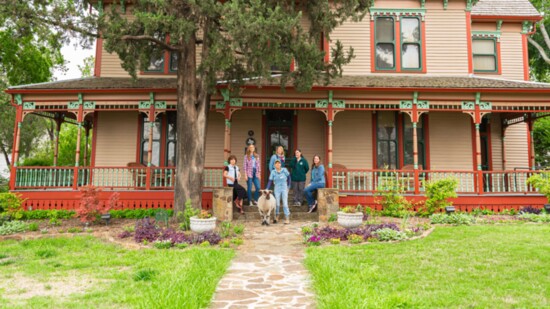Plano had just turned 18 — when its now crowned jewel first shone on a blackland prairie that would ultimately evolve the city into a retail hub for area farmers.
Today, that crowned jewel — aka the "Farrell-Wilson House" — annually draws 35,000-plus visitors.
Folks arrive not only to tour the Victorian farmhouse but also to experience the agrarian ambiance that engulfs it.
The home, along with other historic structures, sits on 3.67 acres. In 1986, the property officially opened to the public as the Heritage Farmstead Museum, a bucolic step into a shrinking past.
As I stroll the grounds this morning, a jumbo jet, a blaring horn, and an idling bus remind me of an abutting cityscape.
But the more resonant sounds are of guttural guinea fowl, turkeys, pigs, sheep, and goats along with a braying donkey and the rooster crowing the break of day.
"I used to take my kids here," says farmstead hand Kathy Wilson. "We were hooked after our first visit."
Wilson, a transplanted city girl from suburban Chicago, is today sporting some cool cowboy boots, apt attire for the museum's vice president of marketing, development, and "livestock."
Wilson actually became agri-savvy 16 years ago when serving as the museum's part-time director of education.
"Our primary mission has always been to preserve this place and learn from its past," Wilson says.
The learning curve must start, she adds, with teaching generations Z and Alpha the importance of "sustainability" — how to meet present needs without compromising future generations' ability to meet their own needs.
Kids who witness the farmstead's sustainability up close will be inspired, Wilson reasons, to become preservationists themselves.
"We want to let kids roam the farm so they can touch what they have been reading about in books."
In addition to seasonal events, the museum facilitates school field trips and offers summer camps and volunteer opportunities for kids from pre-K to high school.
Much farmstead "edutainment" focuses on Central Texas' blackland prairies, a 300-mile swath of land running from the Red River to San Antonio.
This life-sustaining prairieland proved most vibrant during the years Mary Alice — the Farrell-Wilson House's original matriarch — was married to Hunter Farrell (1891-1929).
Farrell, a wealthy entrepreneur, bought 365 acres of blackland prairie and promptly built the aforementioned home as a wedding gift for his fiancée.
But Farrell was never a farmer. In fact, his business often kept him away, leaving Mary Alice and Ammie — Mary’s daughter from a previous marriage — to manage the farm along with hired hands overseen by Ernest Sanders, a former slave's son.
The farm's turn-of-the-century cash crop was wheat. But Ammie, just 11 years old when she and her mom moved into the farmhouse, would one day return to the estate and convert her then-deceased mother's wheat fields into pasture for prized Hampshire sheep.
In fact, Ammie Wilson, an accomplished and spry shepherdess, wound up winning first place at Chicago’s 1952 International Livestock Exhibition when she was 72.
Then, in 1968, Dudley Wilson, Ammie's husband of 53 years, died in a tragic car accident.
Four years later, Ammie passed and, in keeping with her mom's wishes, the farm was willed to Buckner Orphans Home of Dallas.
The orphanage sold the property in 1975 to the William Herbert Hunt Trust Estate, which, that same year, sold 4.15 acres to the city of Plano.
The city then leased the acreage to the Plano Heritage Association, which proved instrumental in creating the museum.
